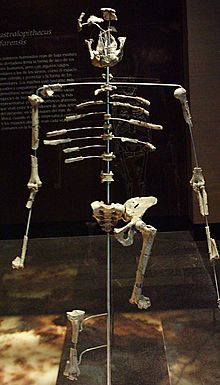Australopithecus afarensis facts for kids
Quick facts for kids Australopithecus afarensis ("Lucy")Temporal range: Pliocene
|
|
|---|---|
 |
|
| Lucy replica, Museo Nacional de Antropología, Mexico City | |
| Scientific classification | |
| Kingdom: | |
| Phylum: | |
| Class: | |
| Order: | |
| Family: | |
| Subfamily: | |
| Genus: | |
| Binomial name | |
| †Australopithecus afarensis Johanson & White, 1978
|
|
Australopithecus afarensis was an extinct hominid, which means it was an ancient relative of humans. This species lived a very long time ago, between 3.9 and 2.9 million years ago. They lived in parts of eastern Africa.
One of the most famous fossils from this species is a partial skeleton named Lucy. Her discovery helped scientists learn a lot about how our early ancestors lived and moved.
Contents
Who Were Australopithecus afarensis?
Australopithecus afarensis had a slender body. They were not as big or strong as some later human ancestors. Scientists believe they could walk upright on two legs, just like modern humans. This way of moving is called bipedalism.
They likely spent some time in trees too. This might have been for safety or to find food. Their arms were a bit longer than a modern human's, which would have helped them climb.
What Did They Eat?
These early human relatives likely ate a diet of plants. This included fruits, nuts, seeds, and roots. They probably also ate insects or small animals when they could catch them. Their teeth were suited for chewing tough plant materials.
Where Did They Live?
Fossils of A. afarensis have been found in eastern Africa. Important sites include Hadar in Ethiopia and Laetoli in Tanzania. These areas were likely a mix of woodlands and grasslands.
The Discovery of Lucy
The most famous A. afarensis fossil is the partial skeleton named Lucy. She is about 3.2 million years old. Donald Johanson and his team found her in Ethiopia in 1974.
When they found Lucy, the team was very excited. They celebrated by playing the Beatles song Lucy in the Sky with Diamonds. This is how the skeleton got her famous name. Lucy's skeleton showed that A. afarensis walked upright. This was a very important discovery for understanding human evolution.
Other Important Finds
Besides Lucy, other important A. afarensis fossils have been found. These include the "First Family" group of fossils. There is also a young female skeleton called Selam, or "Lucy's Child." These finds help scientists learn more about how A. afarensis grew and developed.
Connection to Humans
A. afarensis is thought to be an ancestor of the genus Homo. The Homo genus includes modern human species, Homo sapiens. This means A. afarensis might be a direct link to our own species.
Scientists study these ancient fossils to understand how humans evolved. They look at how our ancestors changed over millions of years. This includes changes in how they walked, what they ate, and how their brains developed.
Images for kids
-
The lectotype LH 4
-
"Lucy" skeleton
-
Diagram comparing birthing mechanisms of a chimpanzee (left), A. afarensis (middle) and a modern human (right)
See also
 In Spanish: Australopithecus afarensis para niños
In Spanish: Australopithecus afarensis para niños





